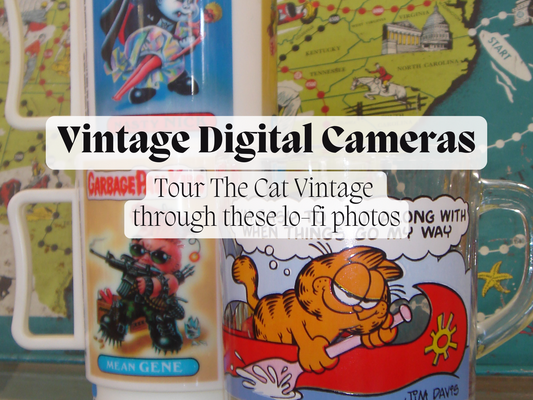In a world of fast-paced technology changes, there’s something undeniably fun and gritty about capturing the present through a lens of the past. At The Cat Vintage, where every corner tells a story of decades gone by, we decided to take a trip back to the early 2000s—not just with our unique finds but through the grainy, nostalgic lens of a Y2K digital camera. Remember when megapixels were a bragging right, and the slightly blurred, warm-toned images were all part of the charm? Explore the shop in lo-fi splendor, where each snapshot feels like a digital time capsule, perfectly capturing the essence of vintage in a way that modern filters can’t touch.

Colorful vintage felt pennants and other unique retro furniture and decor in a corner of the The Cat Vintage storefront

A yellow striped 1970s vintage stuffed chair displays a few groovy mid century floral suitcases.
Digital Camera History
Digital camera technology began its journey into mainstream consumer use in the mid-1990s, marking a significant shift in the way people captured memories. Our grandmother was a photo-enthusiast all her life and I remember frequently picking up a heavy envelope of film she had developed at our local Walmart. She took pictures of everything around her she thought was beautiful, little moments here and there. Like many others at the time, she had tons of point and shoot cameras but was a little late to diving into the digital age.
Early digital cameras were expensive and limited in resolution, but by the late 1990s and early 2000s, technological advancements made them more accessible to the average consumer. The first widely adopted models, like the Sony Mavica and Kodak DC series, offered a revolutionary alternative to film, allowing users to instantly view, delete, and share photos without the need for development.
An early Sony Mavica available on Ebay
Memory cards replaced floppy disks, and megapixels increased. Digital cameras rapidly evolved from novelties into household staples. By the early 2000s, compact point-and-shoot cameras were found in many homes, and capturing everyday moments became easier than ever before. This democratization of photography set the stage for the selfie culture and instant sharing we take for granted today, forever changing the way we document our lives. Imagine if you had to pay for every picture you took today? I know personally I'd be in debt!
What's do people like old digital cameras?
People are rediscovering old digital cameras from the early 2000s for their unique aesthetic, simplicity, and nostalgic appeal. Unlike the high-resolution, perfectly polished images that dominate today’s smartphone and DSLR photography, these early digital cameras produce grainy, low-megapixel photos with muted colors, slight blurriness, and a raw, lo-fi charm that feels authentic and unfiltered. This imperfect quality offers a refreshing break from the relentless pursuit of perfection seen on social media, bringing back the fun, candid feel of capturing moments just for the joy of it. My old digital camera doesn't pull me into the rabbit hole of social media with a quick notification.
These cameras are often seen as a tangible connection to a simpler time before the dominance of touchscreen technology and social media, when taking photos was more about capturing memories than curating content. The physical act of using these older devices—complete with their clunky buttons, slower processing speeds, and retro designs—adds a layer of intentionality and novelty to the photography experience. For many, it’s a way to embrace the past, slow down, and enjoy a nostalgic, creative process that stands in stark contrast to the polished, fast-paced digital world of today.
The Cat Vintage in Lo-Fi Digital
Here are some photos of The Cat Vintage through the lens of a Y2K digital camera, my OG Sony Cybershot 5.1 megapixel point and shoot.





Get a retro digital camera!





